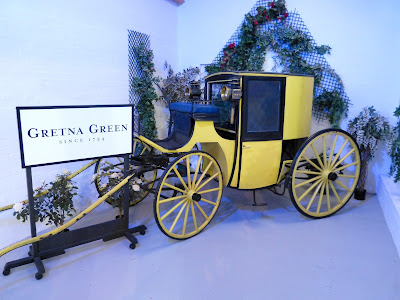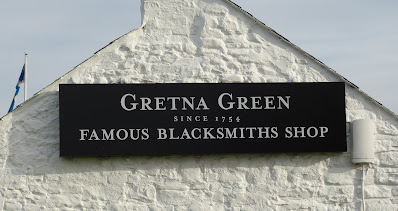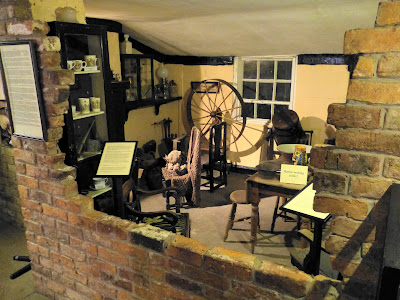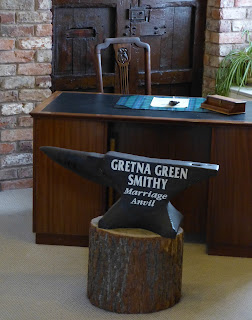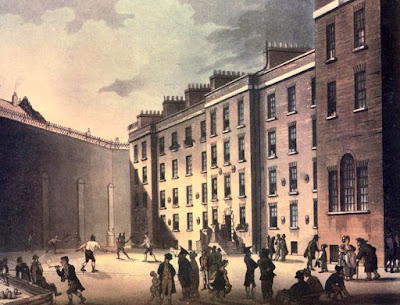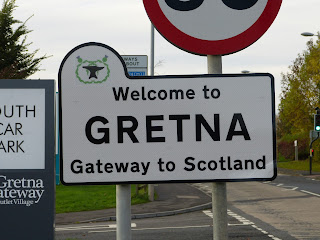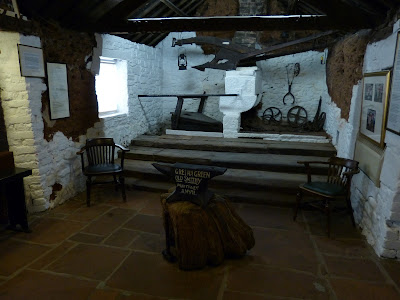Each day during advent I posted a different Regency era Christmas fashion on my
Facebook page. Here are the 24 fashion prints which all appeared in the December issues of either
La Belle Assemblée or
Ackermann's Repository between 1806 and 1820.
Pre-Regency: 1806-1810
1806 - English morning dress: “Of French cambric, made with a train; plain waist, rather high behind, and sharply rounded at the chest; trimmed round the bottom with muslin à la corkscrew; long and very full sleeves, edged at the hands with the same; a blue ribband round the waist, terminating with bows and ends on the right side. The cap à la cloister, entirely concealing the hair, flowing loose, and shading the face on the left side, gathered above the right eye-brow in a sort of irregular nosel, and simply confined round the head with a blue ribband, which finishing behind with a bow, forms the crown, or caul of the cap. A neckerchief, or shirt, sitting full in the front, and high towards the throat, with a deep falling collar, embroidered at the edge. Limerick gloves, and jean shoes.”
Mourning full or opera dress: “A Spanish vest and petticoat of Italian crape, worn over white satin, with a rich border of embossed velvet, terminating at the extreme edge with a narrow Vandyke, or fringe of bugles; the petticoat gathered in a drapery towards the right knee, with a chord and tassels; the front of the vest made high, and formed in irregular horizontal gathers; confined with two narrow bands of bugles, terminating at the corners of the bosom, where the vest flows loose, and forms the square bust, which is finished with a pearl or diamond brooch in the centre. A short full twisted or rucked sleeve, bordered at the bottom similar with the vest. The hair in a plain band round the right temple, relieved, and terminated by loose curls, which commences on the crown of the head, and flow in long irregular ringlets from the left eye-brow, so as to reach the shoulder.” From La Belle Assemblée (Dec 1806).
1806 - Parisian morning walking dress: “Of twill sarsnet, cambric or velvet, embroidered round the bottom and up the right side, where it confines the front which wraps under it, with three bows and the ends of correspondent ribband; long waist with robin front; and long sleeve, nearly to fit the arm.” Worn with a “poke bonnet, of woven willow, or fancy straw, blended with crimson velvet”.
Ball dress: “A frock of white Italian crape, over a white satin slip; the latter edged with a narrow border of pink velvet at the feet; the frock festooned with gentle curves round the bottom, with single Persian rose” and the hair “divided behind; part formed in braids, and brought in loose loops over the right eye”. From La Belle Assemblée (Dec 1806).
1807 - Morning dress: “A round cambric gown, a walking length, with short full sleeve, and puckered cuff, buttoned or laced down the back, and made high round the neck , with a full frill of lace. A military stock, edged round the chin with the same. A figured Chinese scarf, the colour American green, twisted round the figure in the style of antique drapery. Melon bonnet the same colour, striped, and trimmed to correspond with the scarf.”
Morning walking or carriage dress: “A simple breakfast robe of Indian muslin, or cambric; with plain high collar, and long sleeve. Plain chemisette front, buttoned down the bosom. A Calypso wrap of morone velvet, or kerseymere, trimmed entirely round with white ermine, or swansdown.” Worn with a “mountain hat of white imperial beaver, or fur, tied under the chin with a ribband the colour of the coat. Gloves and shoes of American green, or buff. Cropt hair, confined with a band, and curled over the left eye.” From La Belle Assemblée (Dec 1807).
1808 - Carriage costume: “A round robe, with short train and long sleeves, of fine grey cloth, shawl muslin, or velvet. A Spanish cape, or pelerine of the same. Each extremity bordered with a narrow crimson velvet, or chenille. A helmet bonnet of crimson velvet, ornamented with narrow sable, or other well-contrasted fur.”
Carriage costume: “A round high morning robe, of muslin or cambric; with long sleeves, worn quite plain, or otherwise ornamented with lace or needlework. A Spanish mantle, or cloak of purple, green or flame coloured cloth, lined and trimmed with skin, with high collars, and Maltese hood”. From La Belle Assemblée (Dec 1808).
1809 - Evening dress: “A white satin round robe, with demi-traine. A short sleeve of interjoined lace and gold beading. A military front, composed of gold cord and frogs. A peleriae of white satin, with full collar, and border of swansdown, and a rich cord and tassel of gold. A Grecian coif of white satin, with appliqued border of lace, and band and crescent of pearls. A long sleeve, of French lace; or a long glove, of French kid; with bracelets and necklace of pearl. Crimson slippers, with gold imperial trimming. Ivory fan, with mount of crimson crape, ornamented with a border of gold jessamine.” From Ackermann's Repository (Dec 1809).
1810 - Evening dress: “An amber colour crape dress, with long sleeves, and frock waist, tied with white ribband; slashed Spanish front, let in with satin of the same colour, ornamented with white beads, the bosom and sleeves trimmed with beads, on the back of the dress is worn a drapery of amber colour satin hanging over the shoulders in front, or tied in a bow behind, which either way forms a pretty finish to the dress.” Worn with a cap “composed of amber plaited ribband and lace, edged with vandyke lace, tied in a bow on the left side, with amber flower in front.” From La Belle Assemblée (Dec 1810).
Early Regency: 1811-1813
1811 - A mourning dress: “A round robe of fine iron-grey cloth or velvet, with long sleeves and demi high front, trimmed down the center of the figure, at a measured distance, with chenille fur, and clasped in the center, from the bosom to the feet, with lozenge clasps of jet; the belt confined with the same. Antique scalloped ruff of white crape; cuffs to correspond. Hungarian mantle, with double capes, trimmed with chenille fur” worn with “a small Eastern turban of grey and silver tissue; short willow feathers (alternately grey and white) drooping on the left side”. From Ackermann's Repository (Dec 1811).
1811 - Riding dress: “Of fine Georgian cloth; colour, a pale lead or olive tinge; ornamented with frogs à la militaire in front, and finished at the pocket-holes to correspond. Beehive hat of fine moss or cottage straw; white lace curtain veil, twisted occasionally round the rim of the hat.” From Ackermann's Repository (Dec 1811).
1812 - Evening dress: “A round robe of fine Georgian cloth, a pale olive colour, with full puckered sleeves, of white satin. Worn with a French quartered cap, composed of satin and thread lace, ornamented with bows of net, and a wreath of barberries. The hair as a curled crop.” From Ackermann's Repository (Dec 1812).
1812 - Morning or carriage costume: “A white cambric round robe, with long full sleeves, stomacher front, and full ruff round the throat. A Russian mantle of pale fawn-coloured cloth or velvet, with capes of the same; trimmed entirely round with angola trimming fur, or full feathered border; and lined with rose-coloured sarsnet, tied in front of the throat, with a ribbon of a correspondent colour. A traveller's hat, composed of fawn-coloured and rose velvet, with curled ostrich feathers on one side.” From Ackermann's Repository (Dec 1812).
1813 - Evening or opera costume: “A round robe of morone or crimson-coloured Merino, kerseymere, or queen's cloth, ornamented round the bottom and up the front with a fancy gold embroidered border” with the “hair disposed in dishevelled curls, falling on the left side, and decorated with clusters of variegated autumnal flowers” and matching “slippers, of crimson velvet, ornamented with gold fringe and rosettes” and a fan of “richly frosted silver crape”. From Ackermann's Repository (Dec 1813).
1813 - Promenade or carriage costume: “The great convenience and novel attraction of this dress, consist in its admitting of a spencer of the same material as the robe (as seen in our promenade figure), which is richly ornamented, à la militaire, with gold braid and netted buttons, forming a sort of epaulette on the shoulders. The spencer is embroidered up the seams of the back, on the shoulders, and cuffs, to correspond with the bottom of the robe” and worn with “a straw or velvet hat, ornamented with feathers”. From Ackermann's Repository (Dec 1813).
Mid-Regency 1814-1817
1814 - Walking dress: “A pelisse, of short walking length, made either in erminette or silk velvet of puce colour, open down the front, and bound entirely round with celestial blue satin, terminating at the feet with a broad border of white lace; high plain collar, and treble copes bound to correspond; full lace ruff. The Spanish hat composed of erminette or velvet and blue satin, corresponding to the pelisse, trimmed round the edge with quilled lace, and ornamented in the front with a plume of ostrich feathers. Half boots, blue kid or erminette. Gloves, Limerick or York tan.” From Ackermann's Repository (Dec 1814).
1815 - Evening dress: “A crimson satin slip, underneath a frock of three-quarters length made of the silver-striped French gauze; the slip ornamented at the feet with clusters of flowers, and a narrow border of white satin edged with crimson ribbon; the frock has a border of white satin, edged to correspond, and is drawn up in the Eastern style, confined by a cluster of flowers. The body of the dress has open fronts, with a stomacher, which are severally trimmed en suite; short open sleeve, to correspond with a quilling of tull round the arm. Head-dress à la Chinoise, composed of pearl; the hair braided, and ornamented with a wreath of flowers. Ear-rings and drops, pearl; necklace, the French neglige. Gloves, French kid, worn below the elbow, and trimmed with a quilling of tull. Sandals, white kid.” From Ackermann's Repository (Dec 1815).
1815 - Walking dress: “Pelisse, of walking length, composed of blue twilled sarsnet, fastened down the front with large bows of white satin ribbon, and ornamented at the feet with a border of leaves formed of the same sarsnet, edged with white satin: the bottom of the pelisse, trimmed with white satin, is drawn into small festoons; sleeve ornamented at the shoulder and the hand to correspond; a French embroidered ruff. A French hat composed of the blue twilled sarsnet, trimmed with white satin edged with blue, and decorated with a large plume of ostrich feathers. An Indian silk shawl of crimson silk, richly embroidered in shaded silks. The pocket-handkerchief French cambric, embroidered at the corners. Shoes, blue morocco, tied with bows high upon the instep. Stockings with embroidered clocks. Gloves, York tan.” From Ackermann's Repository (Dec 1815).
1816 - Carriage costume: “A velvet pelisse of bright carmine red, superbly trimmed with ermine; the tops of the sleeves caught up à-la-Mancheron, with rich military silk chain work, the colour of the pelisse. Russian hussar cap of ermine, ornamented with gold military chain. Limerick gloves and half-boots or shoes of kid, of a correspondent colour.” From La Belle Assemblée (Dec 1816)
1816 - Promenade dress: “A high dress of cambric muslin trimmed at the bottom with a single flounce of work. The body, which is composed entirely of work, fits the shape without any fulness. A plain long sleeve, finished by a triple fall of narrow lace. Over this dress is worn the Angouleme pelisse, composed of crimson velvet, lined with white sarsnet, and trimmed with a single welt of crimson satin, a shade lighter than the pelisse. The body is made exactly to the shape; the back is of course a moderate breadth, and without fulness; for the form of the front we refer our readers to our print; it is confined at the waist, which is very short, by a narrow velvet band, edged to correspond. A small collar, of a novel and pretty shape, stands up and supports a rich lace ruff, which is worn open in front of the throat. The sleeve has very little fulness, and that little is confined at the wrist by three narrow bands of puckered satin. Bonnet à la Royale, composed of white satin, very tastefully intermixed with a large bunch of fancy flowers, and tied under the chin by a white satin ribbon, which is brought in a bow to the left side; a full quilling of tulle finishes the front. Black silk ridicule, exquisitely worked in imitation of the ends of an Indian shawl, and trimmed with black silk fringe. White kid gloves, and black walking shoes.” From Ackermann's Repository (Dec 1816).
1817 - Walking dress: “A high dress composed of bombazeen; the bottom of the skirt is ornamented with black crape, disposed in a very novel style. The body, which is made tight to the shape, wraps across to the right side; it is adorned in a very novel style with pipings of black crape disposed like braiding, and finished by rosettes of crape, in the centre of each of which is a small jet ornament. Long sleeve, tastefully finished at the wrist to correspond with the body, and surmounted by a half sleeve of a new form trimmed with crape. A high standing collar partially displays a mourning ruff. Claremont bonnet, so called because it is the same shape as the one recently worn by the Princess: it is composed of black crape over black sarsnet, and is lined with double white crape. The crown is rather low, the front large, and ornamented by a bunch of crape flowers placed to one side. Black shamoy gloves, and black shoes.” From Ackermann's Repository (Dec 1817).
Late Regency: 1817-1820
1817 - Evening dress: “A black crape frock over a black sarsnet slip. The skirt of the frock is finished by full flounces of the fashionable chevaux de frise trimming. The body, which is cut very low round the bust, is elegantly decorated with jet beads. Short full sleeve, ornamented to correspond with the body. The hair is much parted in front, so as to display the forehead, and dressed lightly at each side of the face; the hind hair is drawn up quite tight behind. Head-dress a jet comb, to the back of which is affixed a novel and elegant mourning ornament; and a long black crape veil placed at the back of the head, which falls in loose folds round the figure, and partially shades the neck. Ear-rings, necklace, and cross of jet. Black shamoy gloves, and black slippers.” From Ackermann's Repository (Dec 1817).
1818 - Evening dress: “A black crape dress over a black sarsnet slip; the body is cut very low and square round the bust, and is tight to the shape; it is trimmed round the bottom and the back with a rouleau of crape intermixed with jet beads; this trimming does not go round the shoulders. The bottom of the waist is finished by rounded tabs. Long sleeve, made very loose, and finished at the band by a rouleau to correspond with the bosom; the fulness of the sleeve is disposed on the shoulder in puffs, which are interspersed with jet beads, some of which also confine it across the arm: this forms a new and elegant style of half-sleeve. The bottom of the skirt is cut in broad scollops, the edges of which are ornamented with narrow black fancy trimming, and an embroidery of crape roses, with branches of crape leaves disposed between each; a second row of this trimming is laid on at a little distance from the first. The front hair is much parted on the forehead, and disposed in light loose ringlets, which fall over each ear. The hind hair is braided, and brought round the crown of the head. Head-dress, a long veil placed at the back of the head, and an elegant jet ornament, consisting of a rose and aigrette, which is also placed far back. Shamois leather gloves and shoes. Ear-rings, necklace and cross, jet.” From Ackermann's Repository (Dec 1818).
1818 - A "fancy mourning dinner dress": “White crape with pointed festoons of the same, fastened at each point by black rosettes, and folds of black satin placed above and below the festoons. Black satin Canezou spenser, elegantly ornamented with white crape. Frederica hat of white crape, surmounted by a plume of black feathers. Necklace of jet; black gloves and slippers.” From La Belle Assemblée (Dec 1818).
1819 - Parisian evening costume: “Dress of gros-d’Eté of a faded violet colour, with white satin sleeves; and ornamented round the border and bust with rich gauze en carreaux, set in separate squares. Buffont sash of white silk net, fastened on the left side. White satin dress hat ornamented with violets, and a superb plume of marabout feathers. Necklace and bracelets of rubies, set in gold à-l’Antique. White satin slippers, and white kid gloves.” From La Belle Assemblée (Dec 1819).
1820 - An English walking dress: “Round dress of fine cambric, with broad honeycomb border, surmounted by two narrow full quilled flounces of the same material. Fichu spencer of black satin or velvet; the fichu points edged round with a rich cordon of black and pink entwined, and terminating by a pink tassel: the tops of the sleeves and cuffs trimmed to correspond. Long elastic scarf of pink net, with very rich white silk tassels. Bonnet to answer the spencer, with battlement edge of pink satin, and ornamented with a small plume of black ostrich feathers; from which depends, on the left side, a beautiful pleureuse feather. Black satin slippers, Limerick gloves, and pink ridicule.” From La Belle Assemblée (Dec 1820).
1820 - Evening dress: “Round dress of celestial blue gros-de-Naples, made partially high, and trimmed down the front and round the border with Jabots volans, with satin rouleaux between the surrounding Jabots. (A drapery scarf shawl of Lyonese silk is often thrown in graceful folds over this dress.) Hat of quadrille gauze of celestial blue and black, with superb plumage of blue marabout feathers: the hair arranged underneath à-l’Anglaise, with a white satin bow in front. Necklace and ear-rings of rubies: carved ivory fan dyed yellow, with a space left white, which is elegantly painted en medallion. Shoes of blue gros-de-Naples, and white kid long gloves.” From La Belle Assemblée (Dec 1820).
Rachel Knowles writes clean/Christian historical romance set in the time of Jane Austen. She has been sharing her research on this blog since 2011. Rachel lives in the beautiful Georgian seaside town of Weymouth, Dorset, on the south coast of England, with her husband, Andrew.
Find out more about Rachel's books and sign up for her newsletter here.
If you have enjoyed this blog and want to encourage me and help me to keep making my research freely available, please buy me a virtual cup of coffee by clicking the button below.
Sources used include:
Ackermann, Rudolph, The Repository of Arts, Literature, Commerce, Manufactures, Fashions and Politics (various)
Bell, John, La Belle Assemblée (John Bell, 1806-1837, London)










